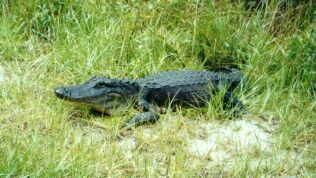What is an Alligator ?


.
American Alligator
What kind of animal is it?
Class: Reptiles
Order: Crocodilia
Order Crocodilia is comprised of 3 families:
(1)Alligatoridae - American and Chinese alligators and caimans. (2) Crocodylidae
- Crocodiles. (3) Gavialidae - gavials.
Family: Alligatoridae
Species: Alligator mississipiensis, (Other species are : Alligator
sinensis, Caiman crocodilus)
Name: American alligator
Where does it live?
Place: Southeastern United States coast
from North Carolina to East Texas
Habitat:
Fresh to mildly brackish water
Needs a good water source for breeding
Requires a land source for shade, shelter and sunning
What does it eat?
- Alligators are not fussy about what they eat;
it can be dead or alive.
- They eat insects, crustaceans, fish, frogs, snakes, waterfowl, and small
mammals. Adults may eat dogs, cattle and other large mammals.
What does it looks like?
- Snout is long and wider than that of a
crocodile
- Teeth don't show and it cannot stick its
tongue out
- Top of animal is a shade of olive green or
brown; the underside is cream or yellow.
- Animal has four short legs, webbed feet and
a long powerful tail.
How big are American alligators?
- Adult females: 6 to 8 feet long
- Adult males: 8 to 10 feet long
What are its enemies and threats?
- Raccoons, bears,
otters, turtles, fish and herons eat alligator eggs and young.
- Probably only 10-20% survive the first 3
years.
- Humans are the only enemy of adult alligators.
How does it protect itself and/or adapt to its
environment?
- Eyes, ears, and nostrils are on top of its head
for breathing in water.
- It can be nearly submerged in water and still
breathe.
- Strong tail and swimming capability are
protection.
What are other facts?
- Male uses its voice, "bellowing", when it is fighting for a mate.
- A young alligator uses a high-pitched sound to alert adults if they are in
danger.
Does it have any other names?
Is it endangered?
From 1967 to 1977 American Alligators were
considered endangered. Now they are listed as threatened.
Reason: At first, animals were sold for leather and as
pets. Now, habitat destruction and hunting threaten them.
Resources
Information adapted from:
Chaffee
Zoological Gardens Website
Photos
from Google "Images"
More information on:
Crocodilians: Natural History and
Conservation
Animal Omnibus



